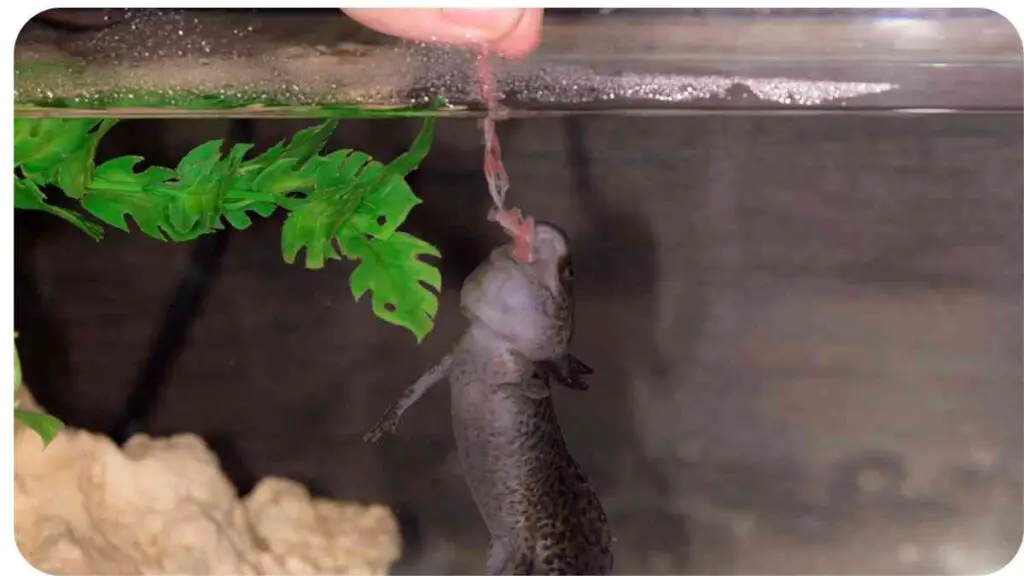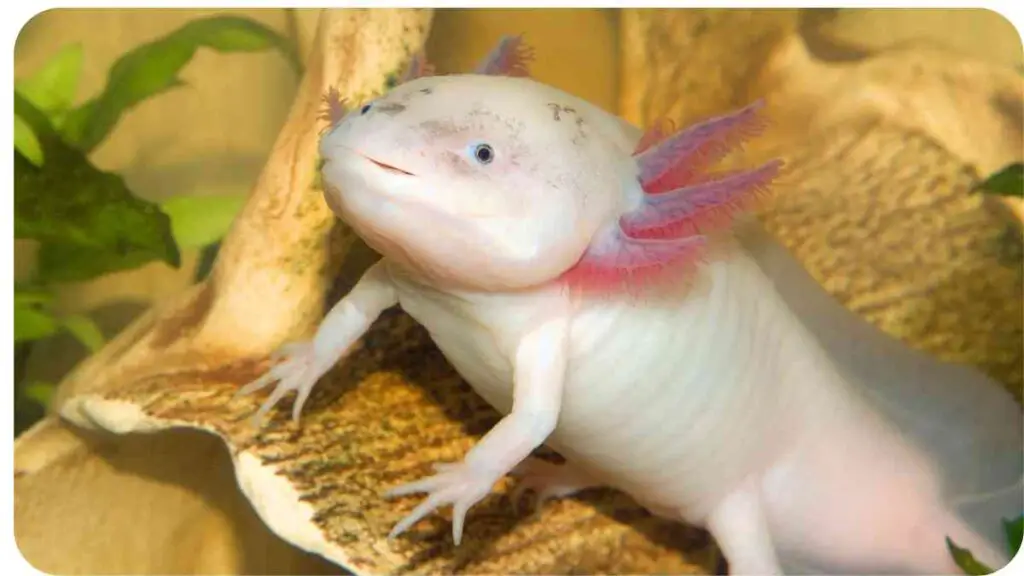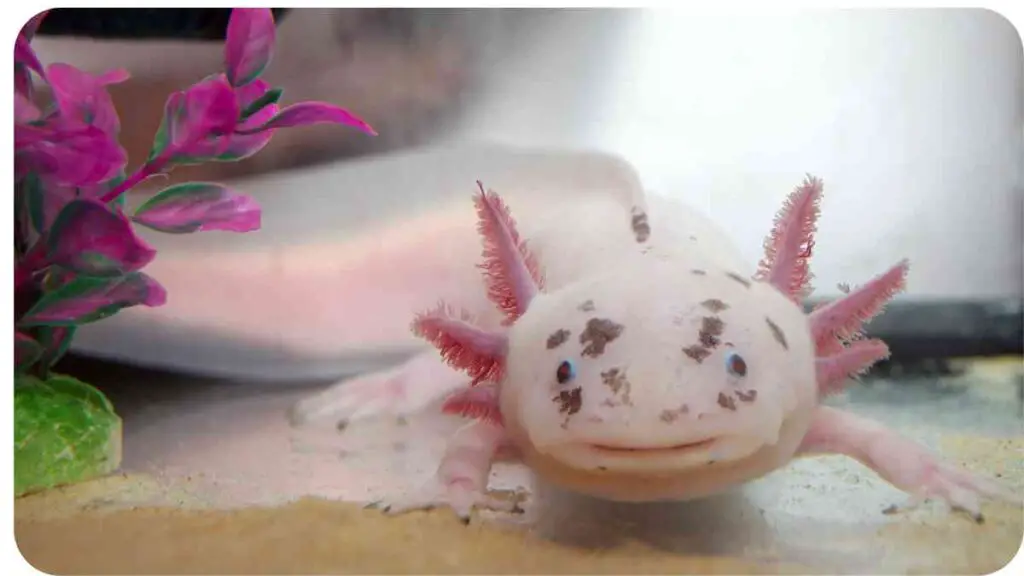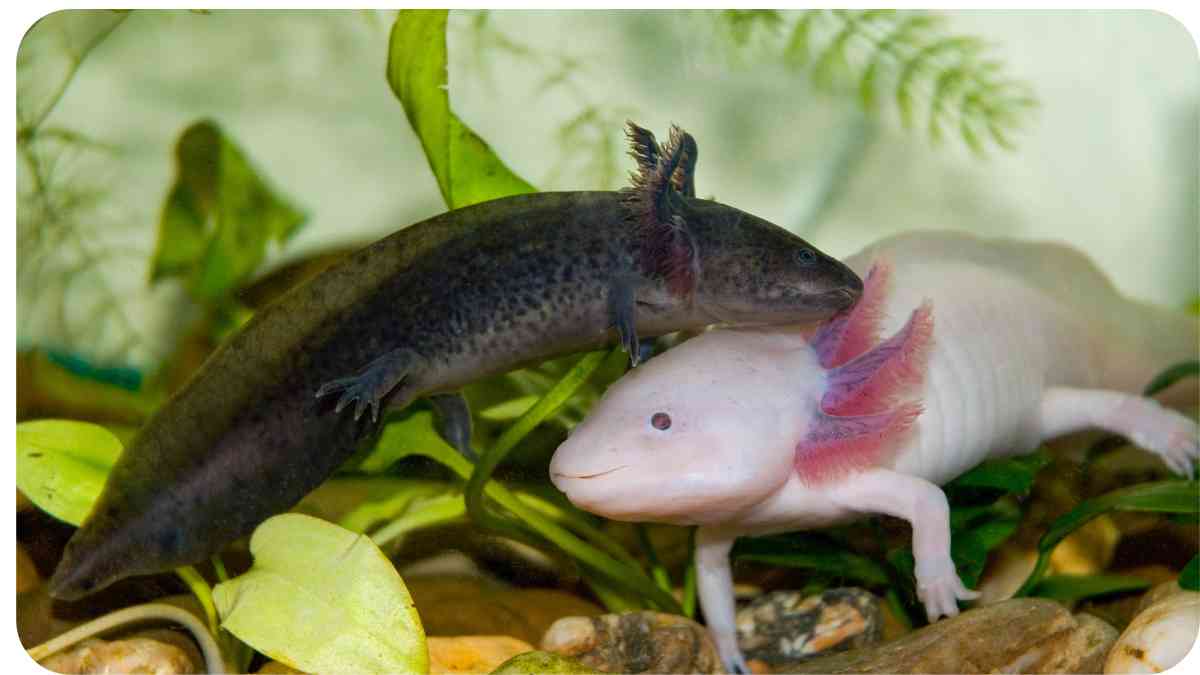Discover the art of caring for axolotls, fascinating aquatic creatures with unique personalities. Whether you’re a novice or seasoned aquarist, this comprehensive guide unveils the secrets to ensuring the well-being of these captivating pets.
From feeding habits to tank maintenance, we delve into the intricacies of axolotl care, offering insights and tips for an enriching experience. Uncover the mysteries of their regeneration abilities, learn about stress factors, and explore the joys and challenges of keeping axolotls in your home aquarium.
| Takeaways |
|---|
| Axolotls require specific water conditions for their tanks. |
| They need a cool temperature range between 60°F and 68°F. |
| Proper filtration is necessary to maintain water quality. |
| Axolotls have sensitive skin and should not be handled often. |
| They primarily eat live or frozen foods like worms and shrimp. |
| Regular tank maintenance is crucial to their overall health. |
| Axolotls have a unique ability to regenerate lost body parts. |
| Providing hiding places in the tank helps reduce stress. |
| They are best kept as solitary pets to avoid aggression. |
| Axolotls can live up to 10-15 years with proper care. |
How Often Should You Feed Your Axolotl

Determining the right feeding frequency for your axolotl is essential for their well-being. The ideal answer to the question “how often do you feed an axolotl” varies based on factors like species, diet, and individual needs. Consult with your pet store or breeder for personalized recommendations.
In general, most axolotls thrive on a feeding schedule of once every 24 hours. This frequency aligns with their coldblooded nature, relying on external warmth for metabolic processes. Prolonged periods without food can lead to a significant slowdown in metabolism, potentially resulting in adverse health effects, even death.
After each feeding session, especially around sunset, it is crucial to promptly clean the tank. Discard any uneaten food to prevent bacterial growth overnight. Neglecting this step can lead to health issues and, not to mention, the potential waste of expensive pellets.
If you’re wondering why axolotls make good pets, our vet answer provides valuable insights into their unique qualities and characteristics. Discover the reasons why axolotls are excellent companions in our comprehensive guide on why axolotls make good pets.
Can Stress Be Fatal for Axolotls?
Yes, stress can indeed be a life-threatening issue for axolotls.
This risk is not exclusive to axolotl caregivers; it’s a concern for anyone responsible for these fascinating creatures. Stress in axolotls often arises from environmental or routine changes.
For instance, altering their feeding frequency—from once to twice a day—may seem insignificant to us, but for these animals, it can induce stress, potentially leading to physiological breakdown over time.
Even seemingly minor adjustments, like relocating their tank to a different room for aesthetic reasons, introduce new smells that may discomfort your pet axolotl.
| Stress Factors | Impact on Axolotls |
|---|---|
| Inconsistent water parameters | May lead to compromised health or even death |
| Poor water quality | Can negatively affect axolotl’s well-being |
| Handling | Excessive handling can cause stress-related issues |
| Overcrowded tank | Increases stress levels and risks to health |
| Inadequate hiding spots | Lack of hiding places can elevate stress |
| Loud or sudden noises | Axolotls are sensitive to noise, causing stress |
Avoiding Stress for Your Pet
Axolotls are not fans of handling due to their delicate, thin skin, which can easily tear when rubbed against humans or other axolotls. In fact, it’s advisable to refrain from handling them altogether.
Their sensitivity to touch is not just a matter of physical discomfort; axolotls are also responsive to scents. Even with clean and sanitary hands, handling can transfer germs or mark them with your scent. This becomes particularly relevant if you ever intend for someone else to care for your axolotl.
While axolotls can be fascinating creatures, it’s important to understand why they may not be suitable as pets. Our vet answer sheds light on the considerations and potential challenges associated with owning axolotls. Explore the reasons why axolotls should not be pets in our informative article on why axolotls should not be pets.
Shedding Light on Nocturnal Habits
While it’s commonly believed that axolotls sleep during the day and awaken at night, the truth is a bit more nuanced.
Axolotls are indeed nocturnal creatures, meaning they are active during the night and tend to rest during the day. Consequently, leaving a light on for your axolotl is unnecessary. However, if you choose to provide illumination, opt for a dim light to mimic their natural habitat.
Understanding the nocturnal nature of axolotls allows for the creation of an environment that supports their biological rhythms, promoting optimal health and well-being.
Decoding Axolotl Age: Rings and Scales

Determining the age of an axolotl involves two distinctive methods: counting tail rings and observing scales.
Counting Rings: Each ring on an axolotl’s tail signifies one year of age. For example, a single ring indicates a 1-year-old axolotl, while two rings suggest a 2-year-old. It’s essential to remember that each ring represents a full year, ensuring accurate age determination. If your axolotl displays four rings on its tail, it is indeed 4 years old.
Counting Scales: Adult male axolotls typically boast 14 small scales on their back between the eyes and the base of the tail fin (including both sides). Conversely, females often have 13 small scales in this area. This distinction provides valuable insights into the gender of your axolotl.
Curious about the reasons why axolotls are considered good pets? Our vet answer delves into the positive aspects of owning axolotls and highlights their unique qualities. Discover why axolotls are good pets in our comprehensive guide on why axolotls are good pets.
Axolotl Dental Evolution: From Teeth to Keratinized Beaks
Contrary to their toothy beginnings, axolotls do not retain teeth in their adulthood. Instead, they undergo a fascinating transformation where teeth are replaced by keratinized beaks.
As adult axolotls, these keratinized beaks, composed of keratin and dentine, function similarly to the hard structures found in bird bills and mammal incisors. This adaptation equips them with the capability to crush and consume various food items, especially crucial for larger carnivorous aquarium inhabitants like fish or frogs.
Interestingly, the presence or absence of visible teeth in pet store axolotls can be attributed to their time spent in captivity before being acquired. This dental evolution adds a unique dimension to the lifecycle of axolotls, showcasing their remarkable adaptability.
| Teeth in Axolotls |
|---|
| Yes |
| Axolotls have teeth |
| Tooth structure |
| Consist of small, sharp teeth |
| Used for grasping and holding prey |
| Located in the upper and lower jaws |
| Assist in capturing and consuming food |
| Teeth regrow if damaged or lost |
Axolotl Social Dynamics: Nipping and Tank Companionship
Axolotls indeed engage in biting and nipping each other, although their bites are generally not forceful and pose minimal risk to healthy individuals.
It’s crucial to recognize that excessive interaction among axolotls or with other animals can induce stress. If considering multiple axolotls in the same tank, even if the space appears sufficient, it’s advisable to either provide separate tanks or strategically manage their time together. This separation, especially during feeding times, helps prevent territorial disputes and minimizes stress.
For single axolotls seeking companionship, cohabitation is feasible as long as there are no conflicts over territory or food. Understanding axolotl social dynamics enhances their well-being, ensuring a harmonious environment for these unique aquatic companions.
Understanding Axolotl Touch Preferences

Axolotls do enjoy being touched, but their preferences are specific. They particularly appreciate gentle petting on their back and head areas. However, they tend to avoid being touched on their belly or tail, often hiding these sensitive areas with their legs.
When interacting with your axolotl, it’s essential to respect their boundaries. Lightly rubbing along the sides of their body can be enjoyable for them. However, refrain from poking or prodding, as you would with a dog or cat. Sensitivity is key, especially around their underarms and near their fins, where they are most sensitive.
Are you a beginner interested in keeping axolotls as pets? Our detailed guide on taking care of axolotls for beginners provides essential information to help you navigate the process. Learn about the key considerations, care tips, and everything you need to know about starting your axolotl journey.
Axolotls and Human Interaction
Contrary to misconceptions, axolotls do not bite humans under normal circumstances. These creatures are not inherently aggressive and typically resort to biting only when they feel threatened.
Moreover, axolotls lack teeth, eliminating the possibility of causing harm during any potential interaction. They are devoid of venom glands and venom production, further ensuring that there is no reason to fear an axolotl attack.
To maintain positive interactions and prevent any potential stress, it’s advisable to keep handling sessions short and sweet. Avoid prolonged attempts to pet or hold them, respecting their natural tendencies and contributing to a harmonious relationship between axolotl and owner.
Axolotl Lifespan
In their natural habitat, wild axolotls can thrive for up to 15 years. However, when kept as pets, their lifespan is typically slightly shortened to around 10-15 years.
The adjustment in lifespan is attributed to the different care provided in captivity compared to their natural environment. While pet owners strive to recreate suitable conditions, it’s inevitable that the care differs from what axolotls experience in the wild.
Understanding this balance between captivity and nature is essential for responsible axolotl ownership. By providing proper care, maintaining a suitable environment, and respecting their unique needs, pet owners can contribute to maximizing the lifespan of these captivating aquatic creatures.
| Species | Average Life Span | Maximum Life Span |
|---|---|---|
| Axolotl | 10-15 years | Up to 20 years |
| Captive-bred Axolotl | 10-15 years | Up to 20 years |
| Wild Axolotl | 10-15 years | Up to 20 years |
| Leucistic Axolotl | 10-15 years | Up to 20 years |
| Golden Axolotl | 10-15 years | Up to 20 years |
The Challenges and Rewards of Axolotl Care
Caring for axolotls demands dedication, making them a challenging yet immensely rewarding choice for pet enthusiasts. While not recommended for beginners, kids, or those seeking an easy-care option, axolotls offer unique attractions for committed caretakers.
These prehistoric-looking creatures bring curiosity value to their owners, showcasing a distinctive appearance that sets them apart. Known for their hardiness and potential to live for decades, axolotls present an enduring companionship that requires a special commitment.
Their care, though not for the lazy or impatient, offers a unique blend of challenges and joys. With no need for daily feeding and fascinating swimming behavior, axolotls create a captivating and enriching experience for those willing to invest time and effort into their unique care requirements.
If you’re wondering whether axolotls are easy to take care of, our comprehensive guide on taking care of axolotls has you covered. Explore the care requirements, maintenance tips, and insights into the level of commitment needed to ensure the well-being of these unique aquatic creatures.
Conclusion
In conclusion, axolotls stand as captivating but not beginner-friendly pets, demanding dedicated efforts from their caretakers. Despite the challenges, the rewards of nurturing these unique creatures make the effort undeniably worthwhile.
For those intrigued by axolotl care, exploring additional resources on feeding, housing, and breeding is highly recommended. These informative guides provide valuable insights into the comprehensive care needed to ensure the well-being and longevity of these fascinating aquatic companions.
In the realm of exotic pets, axolotls shine with their distinctive qualities, making them a fulfilling choice for individuals ready to embrace the complexities and joys of their care journey.
Further Reading
Here are some additional resources to explore for more information on axolotl care and keeping them as pets:
Reptiles Magazine – Axolotl Care Sheet: A comprehensive care sheet that provides detailed information on axolotl husbandry, tank setup, feeding, and more.
The Spruce Pets – Axolotls as Pets: An informative article discussing the basics of keeping axolotls as pets, including tank requirements, feeding habits, and potential health issues to watch out for.
A-Z Animals Blog – Axolotl as a Pet: The Ultimate Guide to Caring for Your Axolotl: A comprehensive guide that covers all aspects of axolotl care, from tank setup and feeding to breeding and common myths about these unique amphibians.
FAQs
How long do axolotls live?
Axolotls have an average lifespan of 10 to 15 years in captivity, but with proper care, they can live up to 20 years or more.
What do axolotls eat?
Axolotls are carnivorous and primarily feed on live or frozen foods such as bloodworms, brine shrimp, and small fish. They should be provided with a varied diet to ensure proper nutrition.
Can axolotls regenerate their body parts?
Yes, axolotls have the remarkable ability to regenerate lost body parts, including limbs, spinal cord, and even parts of their heart and brain. This unique trait makes them a subject of scientific interest.
Do axolotls need a filter in their tank?
Yes, axolotls require a filtration system in their tank to maintain water quality. A good filtration system helps remove waste, toxins, and debris, ensuring a healthy and clean environment for the axolotls.
Can axolotls live together in the same tank?
Axolotls are generally solitary animals and should be housed individually to avoid aggression or stress. While they may tolerate tank mates when young, it’s best to provide each axolotl with its own space as they grow to prevent any potential conflicts.

I am Dr Hellen James a veterinarian, pet lover, and writer. I have many years of experience caring for pets, including dogs, cats, birds, and fish (and even axolotls!). I love spending time with the animals in my life, especially when they are sick or need love.

